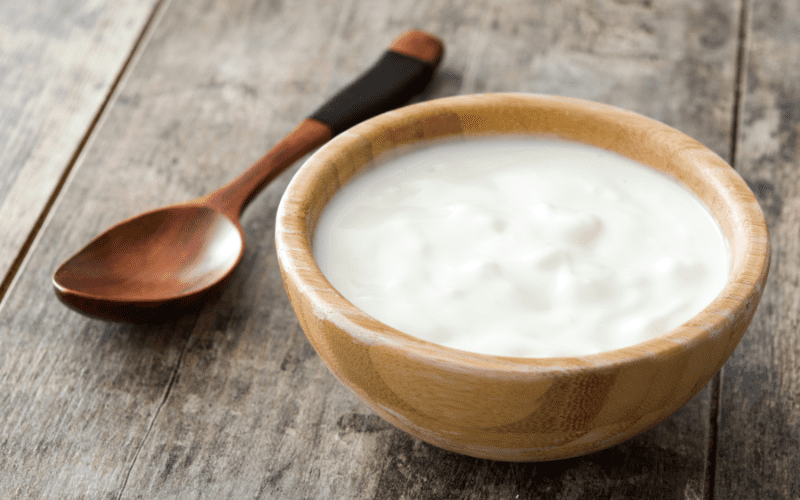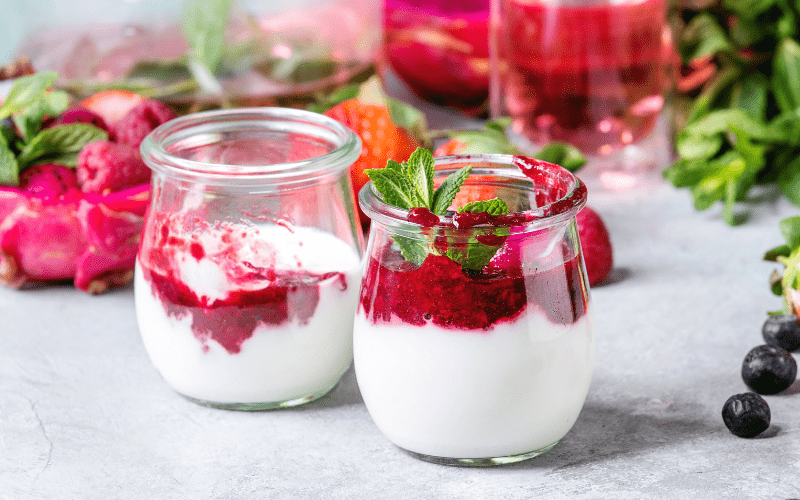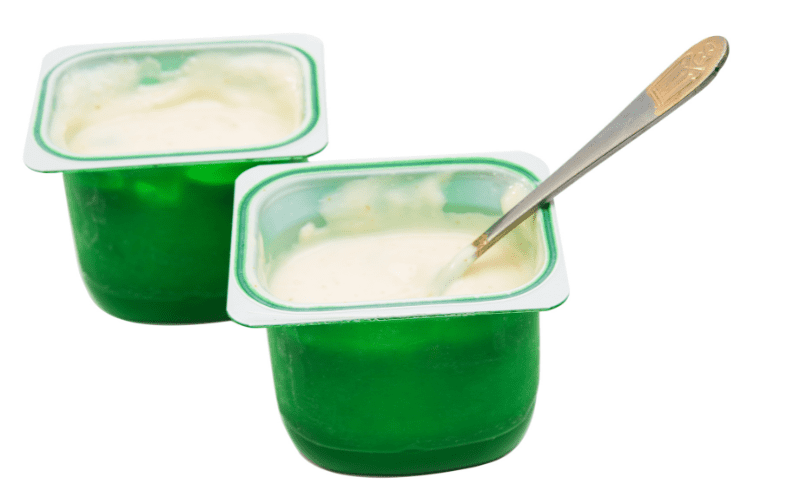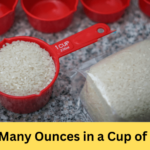Are you a yogurt enthusiast or an aspiring culinary artist looking to whip up some delicious yogurt-based creations? If so, you’ve probably found yourself wondering, how many ounces in a cup of yogurt? Well, fret not, because we’re about to unveil how many ounces of yogurt in a cup right here in this article!
A standard cup of yogurt contains approximately 8 ounces, providing you with a perfect measurement to create culinary wonders.
Now that we have a general answer to how many ounces in a cup of yogurt, let’s delve deeper into understanding yogurt measurements, exploring various types of yogurt, and discovering useful conversions. Join us on this enlightening journey as we unlock the secrets of yogurt measurements!
Introduction: The Versatility of Yogurt

Yogurt is a delicious and nutritious dairy product that is consumed in various ways. From being eaten plain to being used as a base for smoothies, dressings, and desserts, yogurt offers versatility and a unique tangy flavor.
It is also known for its health benefits, including being a good source of protein, calcium, and probiotics.
Understanding Yogurt Measurements

Before we explore the question of how many ounces in a cup of yogurt, let’s understand the basic measurements involved.
Yogurt is typically measured by volume, with cups being the most common unit of measurement in recipes. However, it’s essential to note that the weight or ounces of yogurt can vary depending on its density and moisture content.
How Many Ounces in a Cup of Yogurt?

A standard cup of yogurt usually contains 8 ounces (oz) or 240 milliliters (ml) of yogurt. This measurement applies to most commercial yogurt brands available in the market. However, it’s crucial to check the packaging or label of the yogurt you’re using, as different brands may have slight variations in their cup sizes.
Read more:
How Many Ounces in a Cup of Yogurt: Different Types

So do you know how many ounces in a cup of yogurt? The number of ounces in a cup of yogurt can vary depending on the type of yogurt. Let’s explore the how many ounces in a cup of yogurt for different types of yogurt.
How many ounces in a cup of yogurt regularly?
In general, a cup of regular yogurt weighs approximately 8 ounces or 227 grams. This measurement applies to both flavored and unflavored regular yogurt.
How many ounces in a cup of Greek yogurt?
How many ounces in a cup of yogurt which is Greek one? Greek yogurt is a thicker and creamier yogurt due to the straining process that removes whey and lactose. A cup of Greek yogurt typically weighs around 7 to 8 ounces or 198 to 227 grams. Keep in mind that different brands may have slight variations in weight.
How many ounces in a cup of frozen yogurt?
Frozen yogurt, often enjoyed as a refreshing treat, has a slightly different measurement due to its frozen state. One cup of frozen yogurt weighs approximately 6 ounces or 170 grams.
Converting Other Cup Measurements

Apart from the standard cup measurement, recipes may also call for specific fractions of a cup. Here are some common conversions for Greek yogurt:
How many ounces in 1 2 cup greek yogurt?
If your recipe calls for half a cup of Greek yogurt, you’ll need approximately 4 ounces. This measurement ensures that you have the perfect balance of creaminess and tanginess to enhance your culinary creations.
How many ounces in 1 3 cup greek yogurt?
When you require one-third of a cup of Greek yogurt, you’ll be looking at around 2.6 ounces. This measurement strikes a harmonious balance between creaminess and the desired texture, allowing you to achieve the right consistency in your dishes.
How many ounces in 3 4 cup of yogurt?
If your recipe calls for three-fourths of a cup of yogurt, you’ll be using approximately 6 ounces. This measurement provides a generous amount of yogurt to bring both flavor and moisture to your culinary delights, ensuring a delicious outcome.
By understanding these measurements, you can confidently incorporate Greek yogurt into your recipes, creating delectable dishes with precision and flavor.
Related post: How Many Ounces In A Cup Of Butter?
Yogurt Cups and Their Standard Sizes

Yogurt is commonly sold in individual cups, making it a convenient option for on-the-go consumption.
These cups come in various sizes, typically ranging from 4 ounces to 8 ounces. Some yogurt brands also offer larger family-sized cups or containers, which can hold up to 32 ounces of yogurt.
Yogurt as a Healthy Snack Option

Yogurt is not only delicious but also a nutritious snack option. It provides a range of health benefits and can be enjoyed in various ways. Here are some reasons why yogurt makes a great choice for a healthy snack:
- Rich in Nutrients: Yogurt is packed with essential nutrients like protein, calcium, phosphorus, potassium, and vitamins B12 and B2. These nutrients are important for maintaining strong bones, supporting muscle growth and repair, and promoting overall well-being.
- Probiotics for Gut Health: Yogurt contains live and active cultures, often referred to as probiotics. These beneficial bacteria help maintain a healthy balance of gut flora, supporting digestion and immune function. Consuming yogurt regularly can contribute to a healthy gut microbiome.
- Weight Management: Yogurt can be a valuable addition to a weight management plan. Its high protein content helps increase satiety and reduce appetite, which may aid in controlling calorie intake. Choosing low-fat or Greek yogurt can further assist in weight loss or maintenance goals.
- Improved Digestion: The probiotics present in yogurt can improve digestion and alleviate common digestive issues such as bloating, constipation, and diarrhea. They help maintain a healthy gut environment and enhance the absorption of nutrients.
- Bone Health: Calcium and vitamin D found in yogurt are essential for strong bones and teeth. Regular consumption of yogurt can contribute to bone health, especially in individuals at risk of osteoporosis or other bone-related conditions.
- Versatile and Satisfying: Yogurt is incredibly versatile and can be enjoyed in numerous ways. You can top it with fresh fruits, nuts, or granola for added flavor and texture. It can also be used as a base for smoothies, salad dressings, or even frozen treats.
- Convenient and Portable: Yogurt is available in single-serve cups, making it a convenient snack option for people on the go. It requires no preparation and can be easily packed in a lunchbox or carried in a bag for a quick and healthy snack anytime, anywhere.
- Suitable for Various Dietary Needs: Yogurt comes in different varieties, including lactose-free options and plant-based alternatives. This makes it suitable for individuals with lactose intolerance or those following a vegan or dairy-free diet.
When selecting yogurt, opt for plain or unsweetened varieties to minimize added sugars. You can add natural sweeteners like honey or fresh fruits for flavor. Be mindful of any specific dietary requirements or allergies when choosing yogurt products.
Incorporating yogurt into your daily snack routine can provide numerous health benefits and contribute to a balanced diet. So, grab a cup of yogurt and indulge in this creamy, nutritious delight!
Incorporating Yogurt into Recipes

Yogurt is a versatile ingredient that can elevate the flavor and nutritional value of various recipes. Whether you’re cooking savory dishes or preparing sweet treats, here are some creative ways to incorporate yogurt into your recipes:
- Creamy Smoothies: Add a scoop of yogurt to your favorite fruit smoothie for a creamy and nutritious boost. The yogurt will enhance the texture and provide a tangy flavor while adding protein and probiotics to your refreshing drink.
- Homemade Salad Dressings: Create a healthier alternative to store-bought dressings by using yogurt as a base. Mix yogurt with herbs, lemon juice, garlic, and a touch of honey for a creamy and flavorful dressing that pairs well with salads or as a dip for fresh vegetables.
- Marinades for Meat and Poultry: Yogurt-based marinades not only tenderize meats but also infuse them with delicious flavors. Combine yogurt with spices, herbs, and citrus juice to create a flavorful marinade for chicken, lamb, or even tofu.
- Baked Goods: Yogurt can be a secret ingredient in baked goods, adding moisture and tenderness to cakes, muffins, and bread. Replace a portion of the butter or oil with yogurt to reduce the fat content while maintaining a moist texture.
- Creamy Pasta Sauces: Make your pasta dishes richer and creamier by incorporating yogurt into the sauce. Stir in some yogurt at the end of cooking to add a tangy creaminess to your pasta sauces, such as Alfredo or tomato-based sauces.
- Frozen Yogurt: Whip up a healthier alternative to ice cream by making your own frozen yogurt. Blend yogurt with your favorite fruits, such as berries or mangoes, and freeze the mixture for a refreshing and guilt-free dessert.
- Yogurt Parfaits: Layer yogurt with fresh fruits, granola, and a drizzle of honey to create a satisfying and nutritious breakfast or snack. The combination of creamy yogurt, crunchy granola, and sweet fruits provides a delightful balance of flavors and textures.
- Dips and Spreads: Use yogurt as a base for dips and spreads. Mix yogurt with herbs, spices, and minced garlic to create a flavorful dip for pita chips or fresh vegetables. It can also serve as a healthy substitute for high-fat spreads like mayonnaise or sour cream.
- Yogurt-based Soups: Yogurt can add creaminess and tang to soups without the need for heavy cream. Stir yogurt into warm soups, such as tomato or cucumber soup, just before serving for a velvety texture and a refreshing taste.
- Yogurt Parfait Popsicles: Pour layers of yogurt, fruits, and granola into popsicle molds and freeze them for a delightful and nutritious summer treat. These homemade yogurt parfait popsicles are not only delicious but also packed with vitamins and probiotics.
Remember to choose plain or unsweetened yogurt for savory recipes and adjust the sweetness as per your preference in sweet recipes. With its versatility and health benefits, yogurt can truly transform your culinary creations into flavorful and wholesome delights.
Keep reading:
FAQs
Can I substitute yogurt for milk in a recipe that calls for a cup of milk?
Yes, you can substitute yogurt for milk in recipes. Use the same amount of yogurt as the required milk measurement.
How many ounces are in a single-serving yogurt cup?
Single-serving yogurt cups typically contain around 5 to 6 ounces of yogurt.
Does the fat content of yogurt affect the number of ounces in a cup?
No, the fat content of yogurt does not affect the number of ounces in a cup. The measurement remains the same regardless of the fat content.
Can I use a kitchen scale to measure ounces of yogurt instead of using a measuring cup?
Yes, using a kitchen scale is an accurate way to measure ounces of yogurt. Simply weigh the desired amount of yogurt in ounces.
Is it possible to convert yogurt measurements from ounces to grams?
Yes, yogurt measurements can be converted from ounces to grams. One ounce is approximately equal to 28 grams.
Are there any yogurt brands that offer larger cup sizes containing more than 8 ounces?
Yes, some yogurt brands offer larger cup sizes, ranging from 12 to 32 ounces, for family-sized portions.
How many ounces of yogurt should I use to make a yogurt-based sauce or dressing?
The amount of yogurt needed for a sauce or dressing depends on the recipe. Start with half a cup of yogurt and adjust according to taste and desired consistency.
Can I freeze yogurt in ice cube trays for future use?
Yes, you can freeze yogurt in ice cube trays. Once frozen, transfer the yogurt cubes to a freezer-safe bag or container for easy portioning in future recipes.
How many ounces of yogurt are in a typical single-serve yogurt tube?
Single-serve yogurt tubes usually contain around 2 to 3 ounces of yogurt.
Are there any non-dairy yogurt alternatives available with the same cup measurements as dairy yogurt?
A: Yes, there are non-dairy yogurt alternatives made from plant-based sources like almond, soy, or coconut milk. These alternatives often come in similar cup measurements as dairy yogurt.
Conclusion
In conclusion, the answer to the question how many ounces in a cup of yogurt is crucial knowledge for any yogurt enthusiast or aspiring chef. With a deep understanding of measurements and conversions, we have explored the perfect yogurt measurement. So whether you’re whipping up a delectable yogurt-based recipe or simply enjoying a refreshing snack, armed with this knowledge, you can now confidently measure the right amount of yogurt to achieve culinary perfection. Embrace the versatility and health benefits of yogurt, and let your creations inspire joy and nourishment. Cheers to yogurt-filled adventures in the kitchen and beyond!





